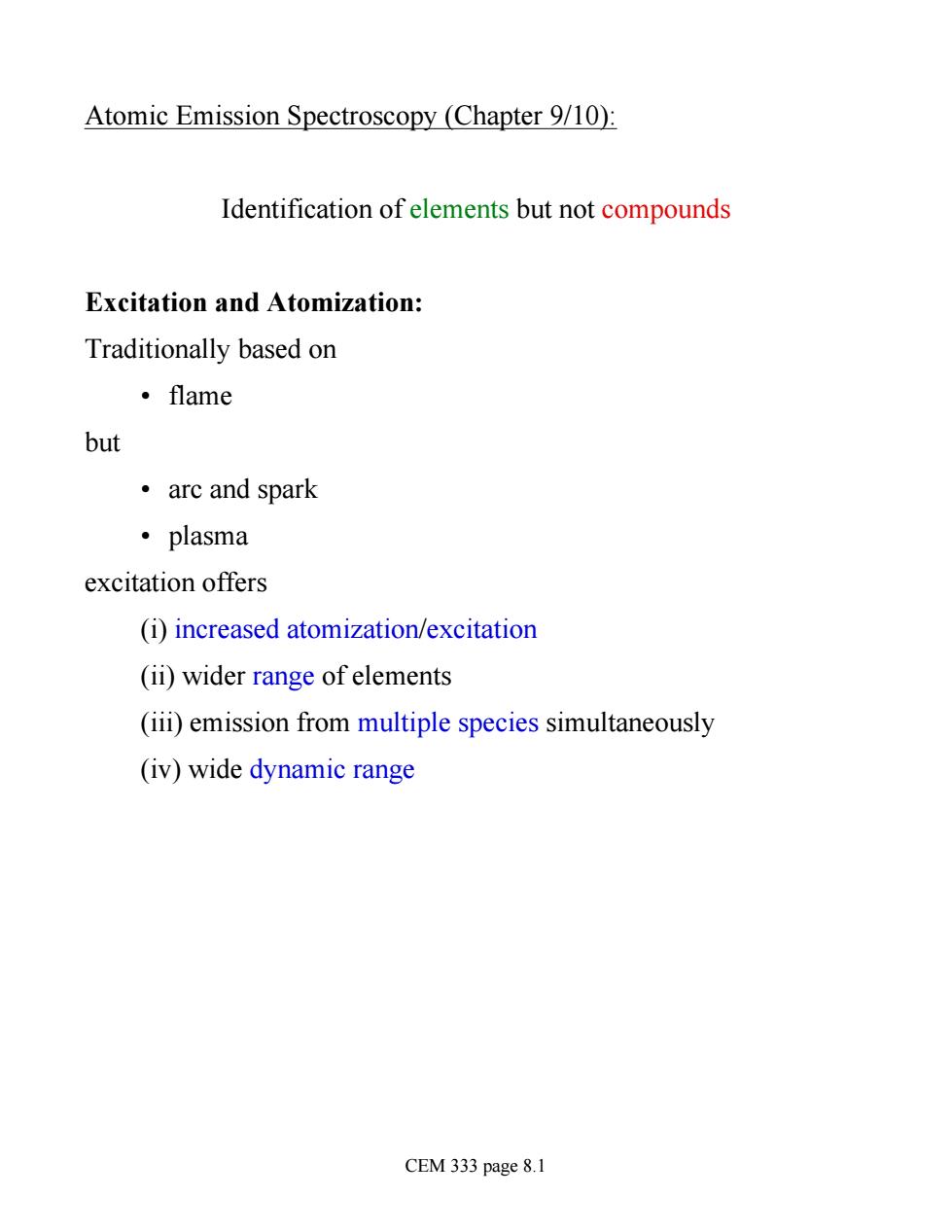
Atomic Emission Spectroscopy (Chapter 9/10): Identification of elements but not compounds Excitation and Atomization: Traditionally based on ·flame but ·arc and spark ·plasma excitation offers (i)increased atomization/excitation (ii)wider range of elements (iii)emission from multiple species simultaneously (iv)wide dynamic range CEM 333 page 8.1
Atomic Emission Spectroscopy (Chapter 9/10): Identification of elements but not compounds Excitation and Atomization: Traditionally based on • flame but • arc and spark • plasma excitation offers (i) increased atomization/excitation (ii) wider range of elements (iii) emission from multiple species simultaneously (iv) wide dynamic range CEM 333 page 8.1
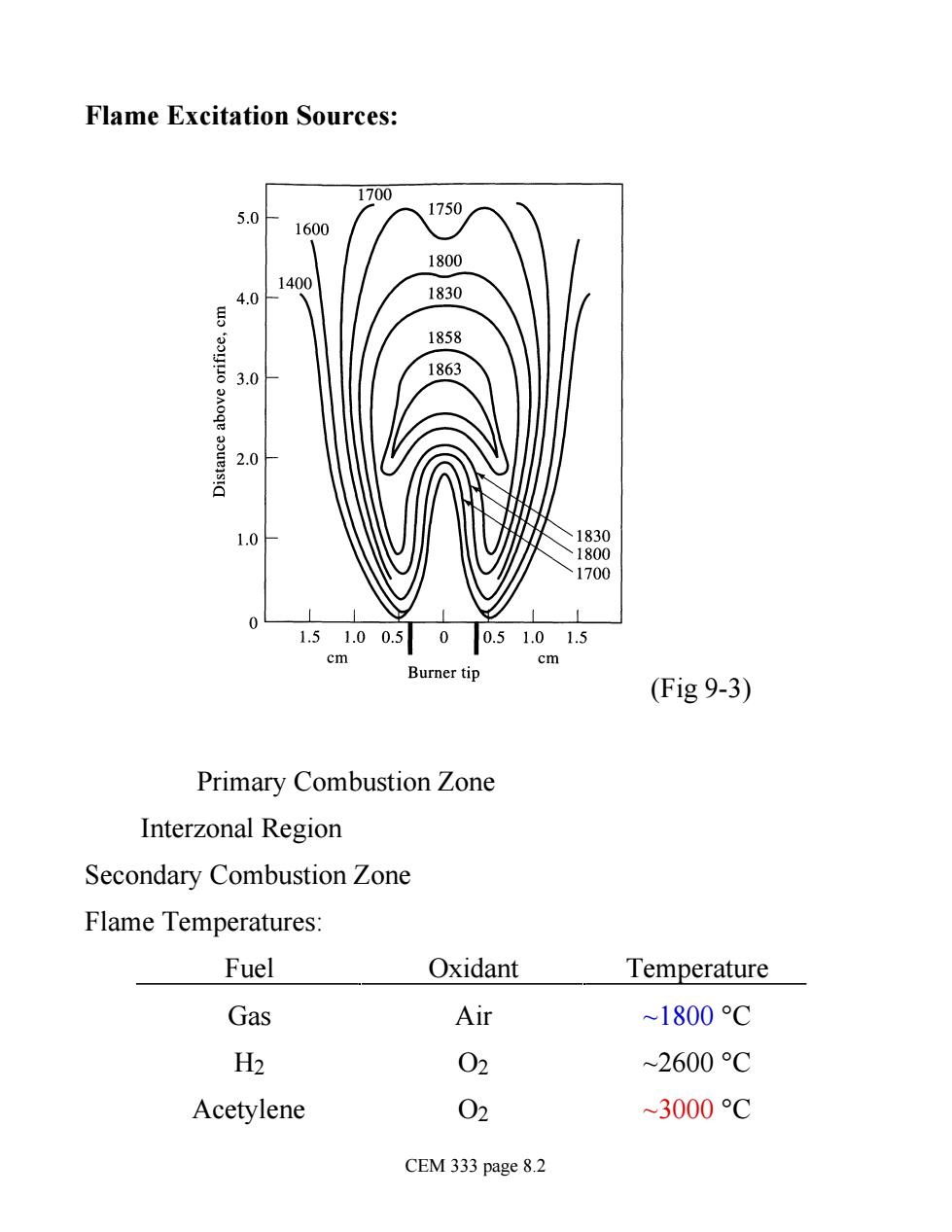
Flame Excitation Sources: 700 5.0 1750 600 1800 1400 1830 1858 30 1830 800 700 1.51.00.500.51.015 em Burner tip cm (Fig9-3) Primary Combustion Zone Interzonal Region Secondary Combustion Zone Flame Temperatures: Fuel Oxidant Temperature Gas Air ~1800C H2 02 ~2600C Acetylene 02 ~3000C CEM 333 page 8.2
Flame Excitation Sources: (Fig 9-3) Primary Combustion Zone Interzonal Region Secondary Combustion Zone Flame Temperatures: Fuel Oxidant Temperature Gas Air ~1800 °C H2 O2 ~2600 °C Acetylene O2 ~3000 °C CEM 333 page 8.2
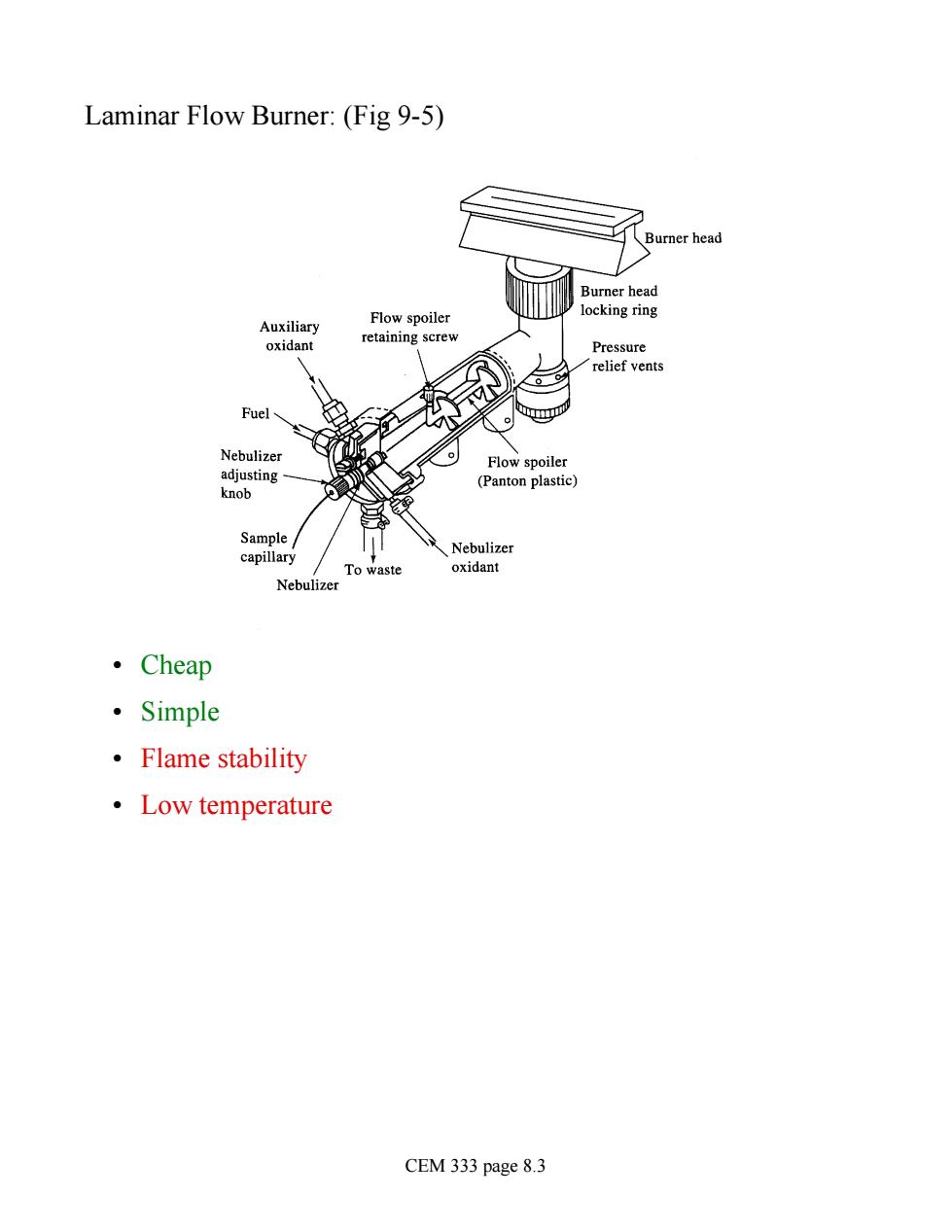
Laminar Flow Burner:(Fig 9-5) ner head ocking ring Auxiliar oxidant relief vents Flow spoile (Panton plastic) To waste Nebulizer ·Cheap ·Simple ·Flame stability ·Low temperature CEM 333 page 8.3
Laminar Flow Burner: (Fig 9-5) • Cheap • Simple • Flame stability • Low temperature CEM 333 page 8.3

Arc and Spark Excitation Sources: Limited to semiquantitative/qualitative analysis (arc flicker) Usually performed on solids Largely displaced by plasma-AES Electric current flowing between two C electrodes (Fig 10-16) Counter Electrodes for electrodes holding sample Sample pressed into electrode or mixed with Cu powder and pressed- briquetting Cyanogen bands(CN)350-420 nm occur with C electrodes in air- He,Ar atmosphere CEM 333 page 8.4
Arc and Spark Excitation Sources: • Limited to semiquantitative/qualitative analysis (arc flicker) • Usually performed on solids • Largely displaced by plasma-AES Electric current flowing between two C electrodes (Fig 10-16) Sample pressed into electrode or mixed with Cu powder and pressed - briquetting Cyanogen bands (CN) 350-420 nm occur with C electrodes in air - He, Ar atmosphere CEM 333 page 8.4

Arc/spark unstable-each line measured >20 s(needs multichannel detection) photographic film ·Cheap Long integration times Difficult to develop/analyze Non-linearity of line "darkness" wavclengths Grating A■Slit Lens Source Fig10-17 CEM 333 page 8.5
Arc/spark unstable - each line measured >20 s (needs multichannel detection) photographic film: • Cheap • Long integration times • Difficult to develop/analyze • Non-linearity of line "darkness" Fig 10-17 CEM 333 page 8.5

(b) 300 32U0 (e) NaZnNa ZnAg CuGe SnCdinCu Li Ir V Sn Fig10-18 multichannel PMT instruments: for rapid determinations(<20 lines)but not versatile routine analysis of solids-metals,alloys,ores,rocks,soils portable instruments CEM 333 page 8.6
Fig 10-18 multichannel PMT instruments: • for rapid determinations (<20 lines) but not versatile • routine analysis of solids - metals, alloys, ores, rocks, soils • portable instruments CEM 333 page 8.6
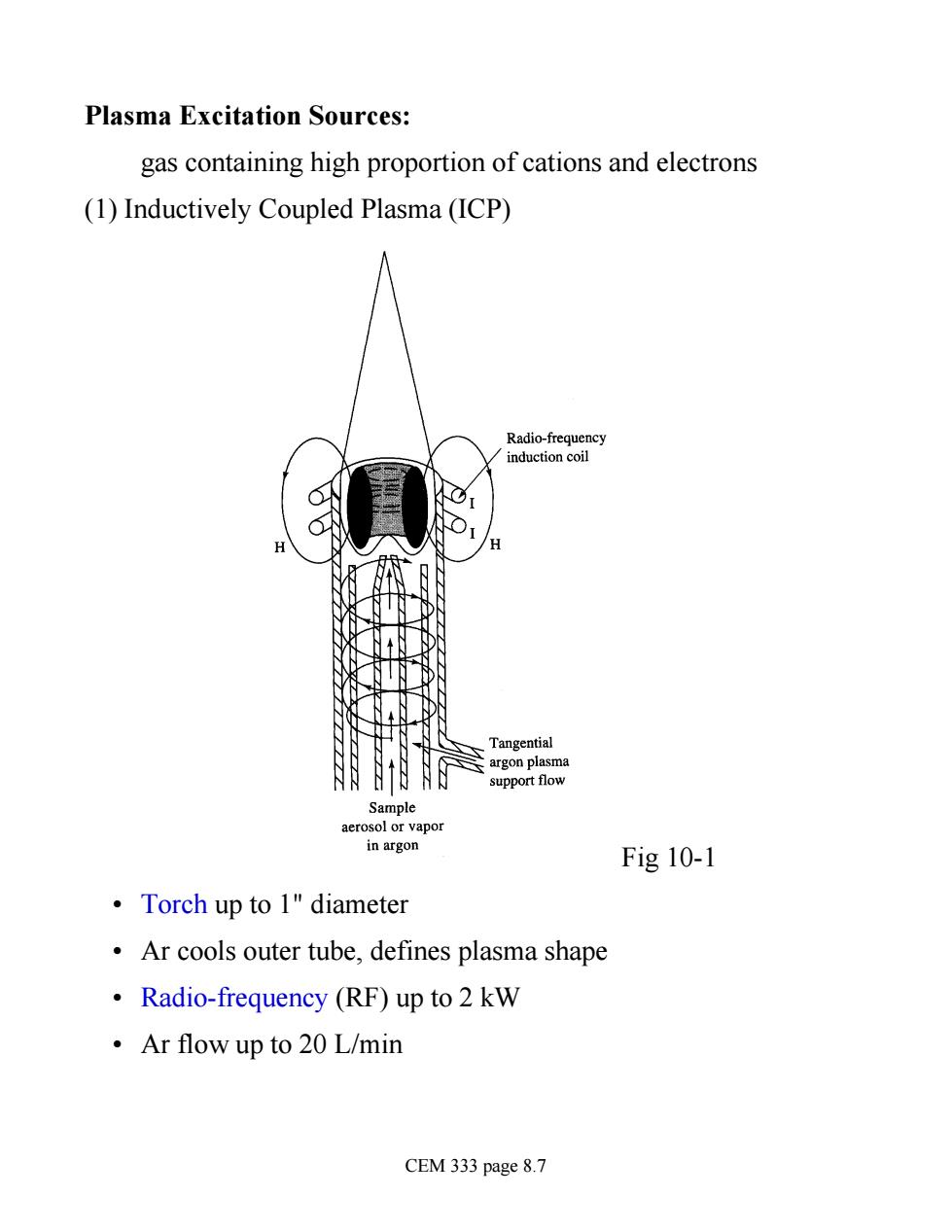
Plasma Excitation Sources: gas containing high proportion of cations and electrons (1)Inductively Coupled Plasma (ICP) Radio-frequency induction coil Tangential support flow Sample aerosol or vapor in argon Fig 10-1 Torch up to 1"diameter Ar cools outer tube,defines plasma shape Radio-frequency(RF)up to 2 kW ·Ar flow up to20L/min CEM 333 page 8.7
Plasma Excitation Sources: gas containing high proportion of cations and electrons (1) Inductively Coupled Plasma (ICP) Fig 10-1 • Torch up to 1" diameter • Ar cools outer tube, defines plasma shape • Radio-frequency (RF) up to 2 kW • Ar flow up to 20 L/min CEM 333 page 8.7

Plasma Structure:(Fig.10-4) Temperature,K (+10%) 25 6000 -6200 8000 10.000 ò Sample acrosol Brilliant white core-Ar continuum and lines Flame-like tail up to 2 cm Transparent region-measurements made Hotter than flame (10,000 K)-more complete atomization/excitation Atomized in "inert"atmosphere Little ionization-too many electrons in plasma CEM 333 page 8.8
Plasma Structure: (Fig. 10-4) • Brilliant white core - Ar continuum and lines • Flame-like tail up to 2 cm • Transparent region - measurements made • Hotter than flame (10,000 K) - more complete atomization/excitation • Atomized in "inert" atmosphere • Little ionization - too many electrons in plasma CEM 333 page 8.8
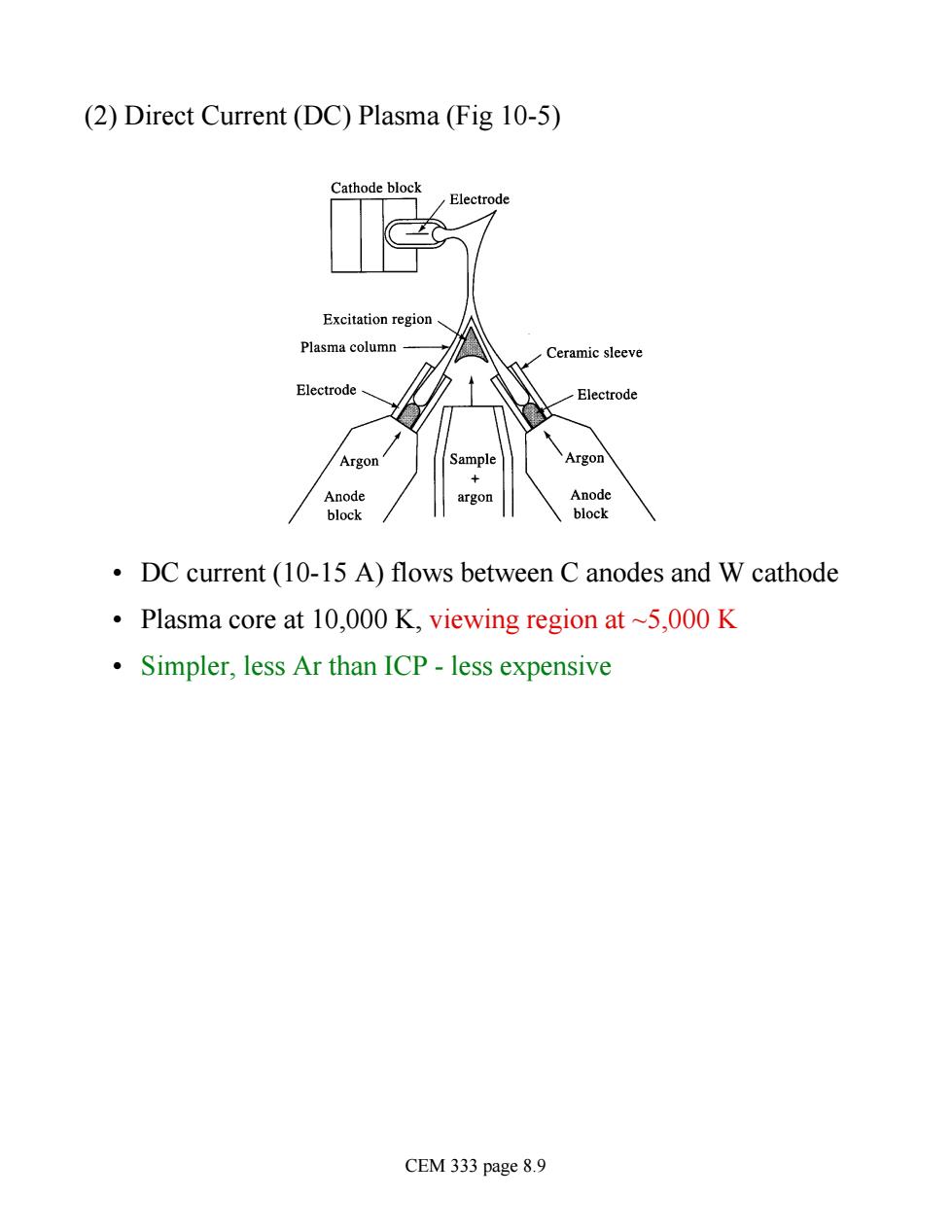
(2)Direct Current(DC)Plasma(Fig 10-5) Cathode block Electrod Excitation region Plasma column- Ceramic sleeve Electrode ample argon DC current(10-15 A)flows between C anodes and W cathode Plasma core at 10,000 K,viewing region at~5,000 K Simpler,less Ar than ICP-less expensive CEM 333 page 8.9
(2) Direct Current (DC) Plasma (Fig 10-5) • DC current (10-15 A) flows between C anodes and W cathode • Plasma core at 10,000 K, viewing region at ~5,000 K • Simpler, less Ar than ICP - less expensive CEM 333 page 8.9
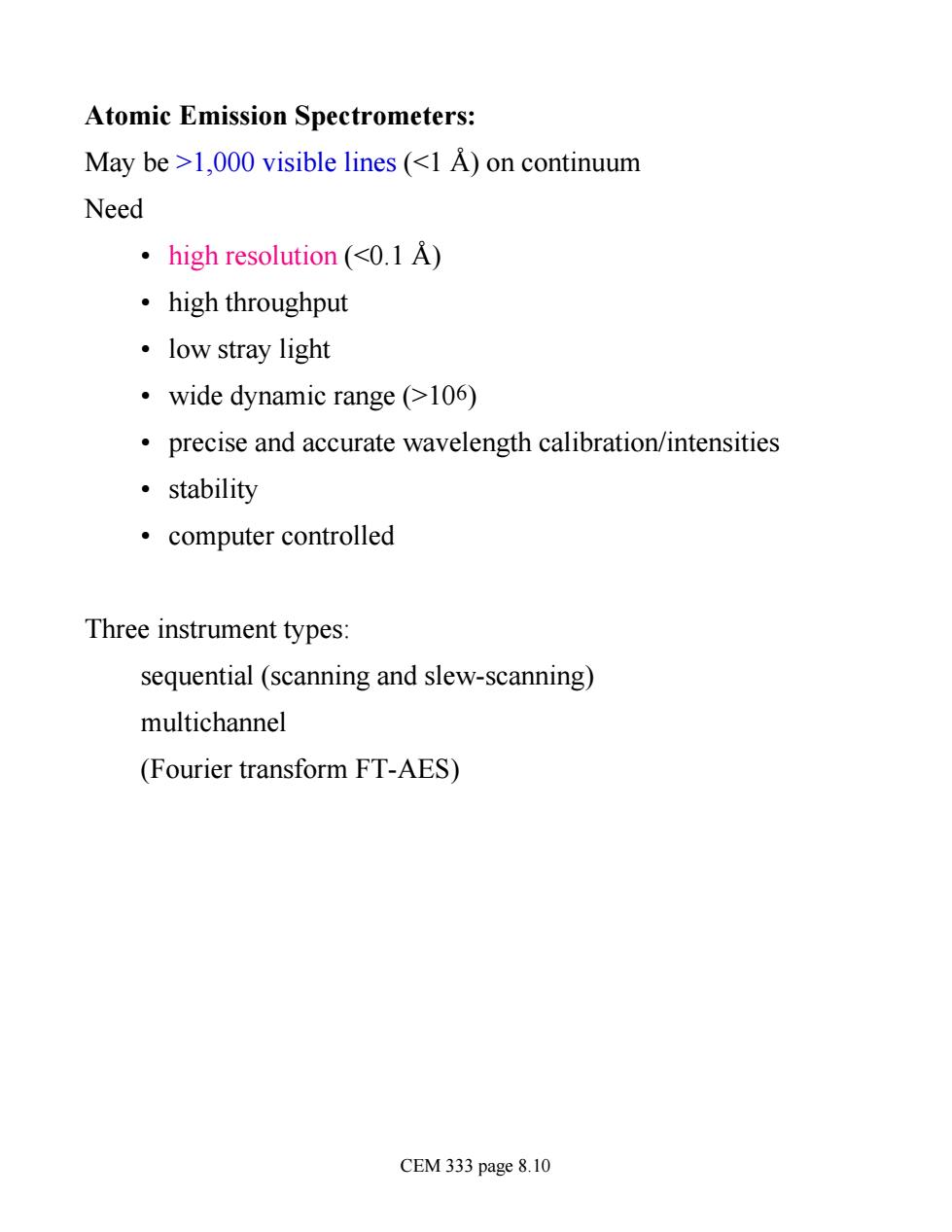
Atomic Emission Spectrometers: May be>1,000 visible lines (106) precise and accurate wavelength calibration/intensities ·stability ·computer controlled Three instrument types: sequential(scanning and slew-scanning) multichannel (Fourier transform FT-AES) CEM 333 page 8.10
Atomic Emission Spectrometers: May be >1,000 visible lines (106) • precise and accurate wavelength calibration/intensities • stability • computer controlled Three instrument types: sequential (scanning and slew-scanning) multichannel (Fourier transform FT-AES) CEM 333 page 8.10